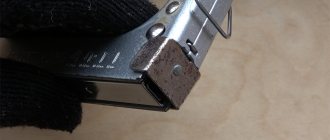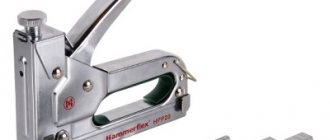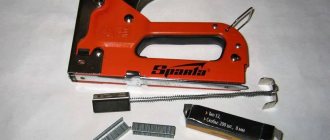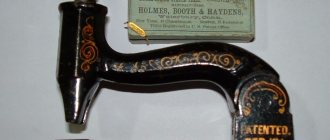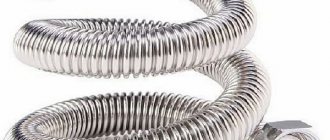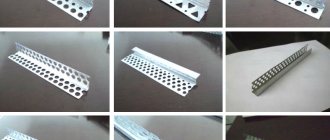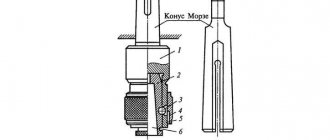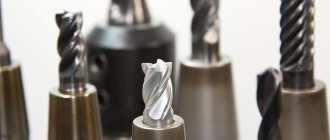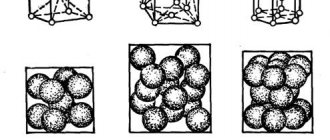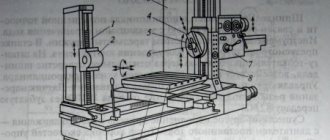Simultaneously with the invention of the office stapler, construction models appeared. Soon the conventional mechanical device was supplemented with an improved electrical version. Both in the office and in construction, the stapler has gained wide popularity. This is a tool that furniture makers cannot do without. If there is a need to purchase this device, then first we will figure out what types of staplers there are and how they differ.
Types of staplers and their purpose
A construction stapler is a device that is used to fasten various materials using special staples. This device is also called a staple gun, staple gun, staple gun, or even a pistol. The tool is popular not only among furniture upholsterers, but also among workers in various fields. It is always useful in the household, because with its help you can quickly and efficiently connect two different parts.
Construction staplers are divided into types based on the type of drive. What they are and how they differ, we will find out further:
- Mechanical is the most common type of device, which is popular not only among home craftsmen. The device is activated by applying physical force. The denser the material into which the staples are hammered, the more effort a person needs to put in. A mechanical stapler is characterized by its small size, low cost and lack of connection to an electrical network or compressor
- Electric - the principle of their operation is the use of electricity. The staples fire when the trigger is lightly pressed. The physical effort required to fire staples in mechanical staplers is replaced by an electric drive. It should be noted that electrical appliances are divided into mains and battery-powered. Mains ones require connection to an outlet, while rechargeable ones are more bulky and require regular battery charging.
- Pneumatic - if mechanical ones use physical force, and electric ones use the force created by an electric motor, then in pneumatic ones, the main drive device is compressed air. This air is supplied from a compressor, so the stapler is tied to the equipment, which makes it inconvenient to use. If electrical and mechanical models are used not only by specialists, but also by home craftsmen, then pneumatic devices are often used only by professionals. The advantage of the tool is its relatively low cost, which is higher than mechanical ones, but less than electric ones.
For home use, a mechanical stapler is sufficient, which, unlike an electric one, can be used in any conditions. Such devices are unpretentious, affordable and provide high reliability of work. It is about manual staplers that will be discussed in the material.
Electric and pneumatic models
The device of an electric tacker connected to a 220 V network is shown in the photo below.
The numbers indicate the following structural elements:
- trigger;
- fuse;
- handle for holding the tool;
- power cable;
- on/off button;
- mechanism for regulating the force of the shot;
- magazine pusher;
- magazine lock.
Inside the instrument body there are also:
- an electric motor that charges the spring;
- electric motor control board;
- impact mechanism.
Battery products do not have a power cord. The power tool receives power from batteries.
Individual design elements of pneumatic staple guns are shown in the photograph below.
Inside the pneumatic tool there is a cylinder with a piston, as well as an air distribution unit. Compressed air for the operation of a construction stapler is supplied through a hose that can withstand high pressure, from a compressor unit or cylinder. Therefore, if problems arise with the operation of a pneumatic tacker, you first need to check the serviceability of the compressor with the air duct.
How does a mechanical device work and the principle of its operation?
The tool in question is activated by applying physical effort. That is why this device is also called a manual stapler. Its design and operating principle differs from that of a stationery device. Construction tools develop a lot of force, which is necessary for fastening or securing materials. According to the design of the drive mechanism, products are divided into two types - with a coil spring and a leaf spring. The main structural elements of a construction stapler:
- Housing - often made of steel, inside which working parts and mechanisms are located. The body has a recess for your hand, which allows you to hold the device during use.
- Handle - connects to the impact mechanism, charging the spring and then firing the staple. It is this handle that the user must exert physical force on to operate the tool.
- The impact mechanism is the basis of the tool, since it is through this device that the staple is fired. The impact mechanism consists of a spring, a hammer, a shock absorber and a striker. The striker acts on the staple, pushing it out and driving it into the material. An integral element of the impact mechanism is also an adjusting screw, through which the force on the bracket is adjusted
- The compartment for installing fasteners is a special channel into which staple cartridges are installed. The ramming mechanism plays an important role in the design of the compartment. This is a special device that pushes the magazine with staples towards the striker as they are used
- Tip - hole through which staples are fed for driving them
- The latch is not the main element of the device, which is intended for transporting the tool. It fixes the handle in an inoperative state, thereby preventing accidental impact on it
A detailed diagram of the structure of a construction stapler is shown in the photo below.
Externally, all mechanical staplers have the same design, but the internal working mechanisms differ in design. The main difference is in the design of the impact mechanism, which is implemented using a conventional coiled and leaf or spring spring. How they differ from each other is described in detail.
- A coil spring staple driver is a common type of stapler that falls under the category of household tools. Their main disadvantage is that they have a large load and recoil force. Long-term use causes physical fatigue in the hands, so the tool is not intended for prolonged use.
The principle of operation of such a stapler is that the handle engages with the striker, thereby moving it upward, overcoming the resistance of the spring. The more the spring is compressed, the stronger the impact on the bracket. When the striker reaches the maximum upper position, it jumps off the handle mount, and thereby it moves downward at high speed, hitting the bracket with the striker. The staple, under the influence of the striker, shoots out of the tip, entering the material. You need to know the operating principle of a construction stapler in order to be able to eliminate its breakdowns when they occur.
- Staple hammer with leaf spring - these staplers belong to the category of professional tools. They are characterized by smooth operation, increased service life, and also higher cost compared to household type staplers. However, this does not mean at all that such a stapler is intended exclusively for professional use. If you plan to use the tool frequently, it is better to take a device with a leaf spring.
The principle of their operation is similar to devices that consist of a coiled spring. When you press the handle, the flat striker moves with simultaneous deformation of the combat plate. As soon as the striker reaches the maximum upper position, it will return to its original position with instantaneous speed. This is achieved due to the fact that the plate tends to take its original position. The hammer, returning downwards, impacts the firing pin, and the latter, in turn, strikes the bracket. Such devices are also equipped with force regulators. They have a more complex design, which is reflected in their cost.
The difference in price between these tools is significant, as is the service life. Before you buy a mechanical stapler for driving staples, you should answer the questions - what is the tool for and how often do you plan to use it.
This is interesting!
You can distinguish a stapler with a coil spring from a device with a plate externally by such a characteristic feature as the location of the adjusting screw. On devices of the first type, the screw is located on top, and on devices of the second type, the adjusting washer is located on the handle.
general information
If you have long been interested in the question of which stapler is better to choose, then it will not hurt you to first find out how this tool for fastening papers works.
Principle of operation
Its design includes a metal groove for inserting staples. To move them forward, a special spring or plate is provided. The latter option is considered more practical, since the spring begins to stretch over time and at one point may come off the hooks on which it is attached.
Thanks to the plate, the staple-moving tongue will operate smoothly. Its main task is to ensure that the clip of staples is constantly located at the edge. The push rod is usually made of metal or plastic. And it’s best if this is the first option, which is characterized by increased reliability.
Loading the stapler
Before work, the staples must be placed in the internal mechanism, after which, when you sharply press the device, staples will shoot out of it and fasten the sheets. When all the clips are used up, you just need to insert a new one to continue working.
Typically, full-load stapler models require one new plate of clamped staples to be inserted. However, there are models in which half the clip is enough to replace the spent staples. It's easy to understand how pocket and office staplers work and how many staples they require. You can easily figure out how to change the plates, for which you don’t even need to look for a diagram of the stationery stapler. You just need to lift the top cover and insert a new clip into the groove.
Office supply stores also offer front-loading staplers. These models have a special button on the body, when pressed, the spring of the mechanism is released and the chute moves forward.
Owners of professional devices may experience certain difficulties in replacing staples. Among them there are models that allow you to load 7 types of staples. But they have one feature - they allow users to choose the bonding depth at their discretion.
Technical characteristics of mechanical staplers
Knowing the structure and operating principle of mechanical type construction staplers, it is also necessary to understand their basic design characteristics. These characteristics include:
- Material - what the stapler body is made of. The most commonly used material is steel, while cheaper options are made from aluminum alloy. The simplest are products made of impact-resistant plastic, but they are not intended for frequent and prolonged use. The handle of steel and aluminum staplers can be covered with a rubber or polyurethane layer
- Dimensions and weight - all mechanical staplers are compact, so there are no difficulties with their storage and transportation. The length of the devices ranges from 155 mm to 230 mm, and the height varies from 120 to 200 mm. The width of 25-35 mm not only characterizes the dimensions of the tool, but also the possibility of using staples of different sizes. Hand-held models weigh from 300 to 800 grams, and if the device body is plastic, then their weight is even less
- Impact force - this parameter for manual staplers is the lowest compared to electric ones, and even more so, pneumatic ones. The impact force is regulated by a special screw, which is equipped with all models of staplers
- Impact frequency or rate of fire - this parameter is measured in the number of staples driven in one minute. For hand tools this figure is the lowest. Electric models show the following results - from 20 to 50 staples per minute, and the most highly productive are pneumatic counterparts, which fire 50-60 times per minute
- The depth of driving the staples - this parameter depends on the impact force of the tool, as well as the type of material for driving the staples. Mechanical staplers are capable of driving 10-15 mm staples, while their modern rivals, electric and pneumatic devices, can handle 50 and even 100 mm fasteners. However, on the farm there is rarely a need to connect various parts using such long staples, especially since it is much more reliable to make the connection using self-tapping screws
It should be noted that manual staplers are designed for driving staples into hard surfaces. Often these are wood, plywood and plastic. The need to use a stapler arises when there is a need to attach woven materials to solid substrates. In addition to the fact that the stapler copes with this task quickly, the resulting result is also decorative, which is why these tools are widely used in the field of furniture construction and repair.
Unlike mechanical devices, electrical and especially pneumatic devices allow you to attach soft materials to hard ones, and even provide a connection between two hard surfaces. For such purposes, staples of appropriate thickness and strength are used. We will learn further about what types of staples for construction staplers are produced.
Stapling Types
Stationery staplers can be divided according to the method of fastening sheets. Among them, the most common option, which is often used by office workers, is closed-type stapler devices. During operation, this tool bends the edges of the staple inward. This method provides the most reliable connection of sheets. Therefore, it is not surprising that such staplers are the most popular.
There are also open type staplers. They differ from devices with a closed stitching method in that they bend the staples outward. They are indispensable when you need to temporarily stitch paper sheets. Subsequently, the fastened sheets can be easily separated, and no traces remain on them.
Some office workers sometimes purchase staplers with straight staples for work. It makes sense to use them when there is a need to fix sheets of paper on a special board with a soft surface. For example, it could be a base made of cork.
Material for making staples for a stapler
Manufacturers produce staples from various materials, which allows them to expand their scope of application. They come in the following types:
- Aluminum - used for working with non-solid types of materials
- Copper - these staples are also called decorative, as they are intended for covering furniture with various types of fabrics
- Steel ones are the most popular and inexpensive. They can be used for driving not only into soft, but also hard materials. The main disadvantage is that they rust over time.
- Stainless - made of stainless steel, and used when it is necessary to prevent the occurrence of corrosion processes
Additional zinc coating of the brackets eliminates the occurrence of corrosion processes. When choosing fasteners of the appropriate material, it is necessary to take into account what you plan to connect.
Additional options
When buying a stationery stapler, few people might think that it can be further improved. However, this is not the case, and this is confirmed by new models that manufacturers regularly release in order to improve their ease of use.
- If you want to get one of these models at your disposal, we recommend that when choosing a stapler, make sure that there is a plastic footrest or rubberized inserts at the bottom of the body. They will help protect the table surface from scratches and other mechanical damage.
- Some models can be additionally equipped with such a useful device as a destapler. Its main purpose is to straighten staples. It may be required if you decide to separate sheets of paper that were once fastened together. Of course, you can use scissors or nails for this, but this is not very convenient, and after such a “barbaric” method, the sheets will no longer look as aesthetically pleasing as before.
Fasteners for staplers according to shape
Staples for construction staplers come in different shapes, which is done specifically in order to expand the scope of their application. The following varieties are distinguished:
- U-shaped
- U-shaped
- T-shaped
U-shaped and U-shaped staples have almost the same shape, but their scope of application is radically different. U-shaped devices are the most popular and are used almost everywhere. U-shaped devices are used in the field of electrical work. With their help, cable lines are secured during their installation. T-staples are an alternative replacement for nails, but they don't require you to hit the head dozens of times to get it into the surface. A distinctive feature of T-shaped staples from nails is that the former have a rectangular or square head shape.
Varieties
Today, manufacturers produce many types of paper fastening devices. Among the rare options, pocket staplers should be highlighted. This product differs from all others in its compact size, which allows you to place this stapler in the palm of your hand. Most often, their body is made of plastic. Using such a tool, you can stitch a small number of sheets of paper at the same time.
Such products are popular among consumers due to their low cost. However, before you decide to purchase one, you should know that they are not suitable for intensive work. If you use it too often, it will soon break down and you will have to look for a replacement.
Office employees most often purchase desktop staplers. But you should know that you should not connect sheets of paper by weight with them. They must be located on a hard, level surface. If you carefully examine their body, you will see a special anti-slip coating in the lower part, which prevents them from moving around the table even during load.
The large stationery stapler stands out among its fellows due to its large dimensions. Its design uses a special lever that serves as the main working element. By pressing on it, you can fasten the required number of sheets of paper. The most powerful models can simultaneously connect no more than 260 sheets.
The hardness of staples and what it affects
The greater the hardness of the consumable, the higher the efficiency of its penetration into the surface of the driven material. To understand why staples of different hardnesses are produced, you need to imagine a picture when it is necessary to drive a staple into a board made of hard wood. A soft aluminum or copper staple will not penetrate the surface of such wood. The result is a damaged bracket with bent legs. To prevent this from happening, manufacturers produce consumables with the following hardness names:
- Simple
- Very hard
- Red-hot
A description of the degree of hardness of the staples is presented in ascending order. The ends of the devices may have additional sharpening, which allows for effective insertion of the part into the surface of solid materials with the least resistance.
How to choose a device: advice from professionals
To choose the optimal stapler, you need to solve the following problems for yourself:
- frequency of use of the tool: every day or from time to time;
- places of use: indoors, outdoors. Is there electricity there?
- Do you need precision driving of equipment;
- materials you plan to work with.
Depending on the purpose and working conditions, choose the type of stapler:
- for infrequent work with non-solid materials, a mechanical stapler is suitable;
- If you don't need precision in installing staples and have the ability to swing, then consider choosing an impact stapler. He's light. Attached to the mounting belt;
- for a large amount of work in places where mobility is needed, take a closer look at a cordless tool;
- if you work indoors with an outlet and don’t want to overpay for the battery, buy a stapler with a mains connection;
- If you need a stationary powerful device, don’t hesitate to take a pneumatic tool.
What characteristics to look for when choosing a stapler:
- presence of impact force regulator. A mechanical tool has two types of regulation: minimum and maximum or smooth adjustment. Electric has up to 6 modes. The setting is made using a software switch. The thinner the material, the less the impact force, otherwise dents will form;
- Double punch. Only electric staplers have it. For hard materials, large equipment is used that will not clog immediately. The double strike mechanism itself determines this and works a second time. If there is no such mechanism, then you will not immediately see that the nail heads are not completely hammered in;
- removing fasteners using a stapler. If this function is available, then to remove poorly hammered equipment you will not have to do it manually or with a nail puller;
- body material. Structural steel staplers weigh more than plastic ones;
- rubber inserts on the handle. Their presence reduces the recoil of the tool, and the hand gets less tired;
- Battery type: nickel-cadmium suitable for low temperatures. But they have a memory effect, so they discharge quickly. They are used in inexpensive models;
- lithium-ion. They hold a charge longer, but are less resistant to mechanical stress;
- nickel metal hydride. Lightweight and have a long charge life;
Selecting staples for a stapler
When purchasing staples, you should know which staples will fit your stapler. The type of equipment is indicated on the packaging, in the instructions and on the tool body. Staples have characteristics that must be taken into account when choosing:
- form. It can be U-shaped or semicircular.
The latter is used for cable installation; Staple shape - type of sharpening of ends: sharpened. Hammering such staples requires less effort;
- unsharpened. They jam more often and do not always clog completely;
- height H;
Staple dimensions
The most common consumable is U-shaped brackets marked “Type 53”. They have found their application in upholstering furniture with textile materials and in joining products made of wood, plywood, chipboard and hardboard. Type 140 staples are in second place in demand. They are shorter and thicker. Due to the increased contact area with the material being joined, the likelihood of material rupture at the point of attachment to the base is reduced. Therefore, they are convenient when working with thin parts: fabrics, PVC film, as well as wood, plywood, chipboard and hardboard. There are two types of semicircular staples.
Types of semicircular staples
| Bracket type | Cable diameter, mm | Thickness, mm | Height, mm |
| S (28) | 4,5 | up to 1.25 | from 6 to 10 |
| L (36) | 6 | 1,25 | from 9 to 11 |
Two characteristics are important for a stapler: shape and size. And you choose the type of sharpening for yourself. By the size of the equipment you can judge the purpose of the stapler.
Examples of types of staples and nails for staplers
| Equipment type | Description | thickness W, mm | width L, mm | height H, mm |
| Type 13 (H/19/37) | Flat metal staples | 0,7 | 10,6 | 6–14 |
| Type 53 (A/3/530) | Thin metal staples | 0,75 | 11,4 | 4–18 |
| Type 140 (G/4/11) | Thin metal staples | 1,25 | 10,6 | 6–14 |
| Type 48 | Nails | 2,8 | 1,65 | 14–25 |
Dimensions of fasteners for construction staples, their purpose and application
Often, when purchasing a mechanical stapler, a set of staples is included with it. These devices come in different sizes, which must be considered depending on their application. Moreover, they differ not only in the length of the back and the height of the legs, but also in thickness. When purchasing them, you can see that the packaging contains the following designations:
- a—thickness
- b - width
The most popular types of staples are the following:
- 53 is the most common version of products, which have a thickness of 0.7 mm and a width of 11.4 mm. Leg height from 4 to 14 mm is selected depending on the task at hand
- 140 - such products have a thickened shape of 1.2 mm with a back width of 10.6 mm. The height of the legs also ranges from 4 to 14 mm
- 36 - this marking indicates that the package contains U-shaped brackets for securing the cable
- 300 are nails for a special staple gun
Below is a table of staple sizes from different manufacturers.
Advantages and disadvantages
Any equipment has its advantages and disadvantages.
It is important to note each of them so that you can make the right choice.
The advantages of a mechanical stapler include:
- Price;
- it has a simple design (this parameter is important, since the simpler the tool is, the less often it will break);
- Mobility;
- Possibility of safe use.
The disadvantages of this type of equipment include the following factors.
- Working with it requires a lot of physical effort.
- It has low speed.
Mechanical stapler.
The advantages of electric include the following advantages.
- When working with it, you do not need to make any physical effort;
- Has a high operating speed;
- The tool has high power.
Among the disadvantages of this type of equipment are:
- The cost is higher than mechanical;
- An electrical connection is required (because of this, they can only work within a limited radius, it all depends on the length of the wire);
- Heavier than the previous type.
Electric stapler.
The positive features of a pneumatic stapler include:
- Work speed at a high level;
- Has great power.
Among the disadvantages of this type of equipment, the following are noted.
- A compressor is required. This affects cost, weight and dimensions.
- In most cases it is used as a permanent installation.
Pneumatic stapler.
How to use a construction stapler correctly
Before using the tool, you must first select the appropriate type of brackets and install them in the device compartment. To charge a new fastener, the following manipulations are carried out:
- The first step is to block the device handle from accidentally pressing it.
- At the back of the tool there is a special hatch with a rod and a pusher (removal mechanism), when removed, a compartment opens for installing a cartridge cassette of staples
- The cassette is installed inside the compartment, turning it so that the legs point down
- Next, we return the ramming mechanism to its place, thereby pressing the staples
- The handle is removed from the safety lock
- The tool is ready for use. Now you can make a few test shots to make sure the device is working.
In a similar sequence, staples of different sizes and shapes are installed or charged. However, before installing the appropriate fasteners into the tool, you must make sure that it is designed to work with them.
After this, you can begin to use the construction stapler for its intended purpose. It is not difficult to work with a furniture stapler, and the only regulator is to adjust the impact force. If, when you try to drive in the staple, it does not go in all the way, then you need to rotate the adjuster in a clockwise direction. If the fastener is deeply recessed inside the material, then it is necessary to loosen the spring pressure.
This is interesting!
When the staples in the gun run out, it is not recommended to click the handle idle.
The mechanism of the tool wears out with each blow, so the device will not last long in this case. Features of adjusting the impact force for household and professional staplers:
- Features of setting household staplers - tightening the screw clockwise helps compress the spring. As a result, the staples are fired with greater force, which will also contribute to its penetration deeper into the material. If you turn the regulator in the opposite direction, the blow will be weaker
- Setting up a professional stapler - the regulator is located near the handle. When it rotates, the impact force also increases or decreases. The tool needs adjustment every time the material being processed is changed.
The tool is considered to be correctly adjusted when the staple is completely inserted into the material. You should start using the tool only after the impact force has been correctly adjusted.
This is interesting!
Often, during the operation of a furniture stapler, a situation arises when the staple does not completely enter the material. The reason for this phenomenon is that the spring wears out. If you adjust the impact force of the screw to the maximum value, and the fasteners do not go in completely, then the tool needs repair.
Professional or household
Like all other tools, construction staplers are conventionally divided into professional and household. The difference in price is very significant - many times over. And this is justified. It's a matter of functionality, number of settings, operating modes and working resource. Household models have a short working life, as they are mainly made of plastic.
Professional models are made of steel, often stainless steel. They have plastic elements, but these are metal handle covers to soften recoil. It is clear that they will work longer, and they are usually easier to work with - staples fit easier, jam less often, etc.
When choosing a manual construction stapler, you need to pay attention to the body, the height of the handle
Yandex.RTB RA-1479455-3
There is also an intermediate class - semi-professional. They fall between these two categories in price and quality. Often it is in this group that you should look for equipment for home use. It works fine and doesn't cost much.
Which construction stapler is better?
Today, a lot of construction staplers are produced, which differ not only in their external design features. They differ in performance and resource. However, one can argue with these words, because the duration of the resource depends on the features of using the tool. Before you buy a construction stapler for your home, it is recommended that you familiarize yourself with the popular models that received the highest rating in the rating - inexpensive and high quality. You can choose which construction stapler is better by yourself by familiarizing yourself with the models presented below:
- STAYER 31510 is an inexpensive and very effective household type stapler. Despite the German name, this instrument is produced in China. It is distinguished by high reliability and reliability. Reviews show that the device is resistant to various negative impacts - falls and shocks. The handle has a rubberized layer, which eliminates the possibility of calluses forming during prolonged use of the tool.
- The whirlwind is a very powerful tool that can cope with any complexity of housework. It is used not only for upholstering furniture, but also for fastening sheet materials. It has a high impact force, which allows it to pierce plywood. This powerful household tool weighs 500 grams, which can be called a disadvantage. Another drawback is the rigidity of the handle, due to which greater impact force is achieved. Reviews show that the resource of the tool with frequent use is quite long, and if you need a reliable stapler, then you should take a closer look at the models from the Vikhr company
- Gigant is another reliable staple gun from the Chinese manufacturer. It has a simple design, which has a positive effect on its cost. The body material is coated with chrome, which ensures reliable protection against corrosion. Impact mechanism made of tool hardened steel ensures long service life of the tool
It should be noted that when choosing, one should take into account such a factor as cost. The higher the price for a particular model, it means the tool is made of higher quality materials and will last longer. If you once had to work with an electric stapler, then you are unlikely to consider mechanical models. However, it makes no sense to buy an electric staple gun if you plan to use it no more than a few times a month. If a mechanical stapler malfunctions, it will not be difficult to disassemble it and repair it yourself.
Not just parentheses
Some staplers can work not only with staples, but also with studs of various shapes. The designations of what the stapler works with are indicated on its body or in the instructions.
I tuck the nails into the stapler in the same way as with staples, but you need to be careful after pulling out the spring. A row of nails must be loaded along one of the outer edges of the letter “P”, and not inside this very letter!
If you want it to produce two nails side by side when working with a stapler, load the second row along the second outer edge. Next, the spring is inserted and the stapler is closed.
Do-it-yourself repair of a construction stapler
Often during the operation of tools, their malfunction occurs. A mechanical stapler is no exception, repair of which may be required soon after purchase if the cheapest option is purchased.
Let's look at the features of repairing a furniture stapler using the example of a malfunction when two staples shoot out.
Why does the stapler shoot two staples, and is it possible to fix such a breakdown? First we need to figure out why it shoots two fasteners. The reason for this malfunction is the weakening of the clamping force of the staple cassette. The pressure is provided by the rammer. Over time, the spring loses its clamping properties, which leads to a defect when the device fires two staples at once.
You can fix this in the following way:
- For staplers with a spring type of spring, make a U-shaped plate and place it between the latch and the rammer. Such a plate will eliminate free movement of the rammer, and as a result the stapler will hit exactly one staple
- For staplers with coil springs, increase the force of the rammer spring. This can be done by adding spacers in the form of washers
A detailed description of the mechanical stapler repair process is presented in the video material.
No less popular is the problem when staples do not fly out of the stapler.
If in the first case the problem is solved without the need to disassemble the device, then here you cannot do without it. It is easy to disassemble the stapler, depending on its model. To do this, remove the cotter pin washers, and then disassemble the tool. Next you need to get to the impact mechanism, since the malfunction is associated with it. Repairing a construction stapler with a malfunction such as staples not firing is as follows:
- The sides of the striker are inspected
- There should be no licked areas where they come into contact with the handle. The presence of such indicates that the striker does not move to the upper position, but jumps off almost immediately when you press the handle
- The licked areas of the edges must be ground off with a grinder, after which we can assume that the tool has been repaired
- All that remains is to assemble it and check the proper functioning
Another type of failure of a mechanical stapler is when the staple shoots out in the shape of the letter “M”.
This type of fastening is not reliable, so the problem must be corrected as quickly as possible. We will consider the reasons for this malfunction and the features of its elimination below:
- If the staples jam in the shape of the letter “M”, then the reason is the development of the striker
- The firing pin is a plate that is connected to the firing pin
- This type of breakdown often occurs due to the fact that the firing pin is made of low quality steel. With prolonged use of the tool, abrasion of the end part of the striker occurs, which contributes to the creasing of staples in the shape of the letter “M”
- Alignment of the striker is carried out using a fine-grain file
- It is important to take into account that it is not recommended to remove a large amount of edge from the striker, as this will affect the reduction in impact force
After repairing the construction stapler, you can continue to use it. The instrument in question is distinguished by its versatility, for which it has gained wide popularity. In conclusion, it should be noted that, like any other type of tool, a furniture stapler needs lubrication. The impact mechanism is lubricated with lithol or grease, which reduces friction and therefore increases the service life of the device.
Why is it necessary?
The device can be called a construction or furniture stapler, as well as an automatic staple gun. The devices were invented about 80 years ago, although the prototype of the modern device was used back in the 18th century.
The history of the stapler dates back to the 18th century
The main purpose of the tool is to fasten materials to the base. As a rule, it is wood or wood-containing boards (chipboard, MDF, etc.). Everything that a stapler can penetrate is nailed to such a surface. This can be a film or membrane for insulating a building, furniture upholstery or its components, roofing felt, carpeting, wooden slats, plastic finishing materials, etc.
The simplest construction stapler
Yandex.RTB RA-1479455-2
The first step is to decide what type of staple gun you want. According to the type of driving force, construction staplers are:
- Mechanical. They are operated by hand force, have low productivity, and a small number of staples that can be “tucked” into it. With such equipment it is quite difficult to work with hard materials - you have to make a significant effort. But mechanical staplers are small in size and weigh little, which allows you to work in awkward positions. Their low price is also attractive, although there are models with a rather high price tag.
- Electrical. The staple flies out when the trigger is pulled, but the trigger mechanism is powered by electricity. There are models that run on mains power, and others that run on batteries. Naturally, productivity is higher than that of manual staplers, but prices are significantly higher, especially for cordless staplers. Also larger in size. Moreover, for models powered by mains power, the cord interferes and limits movement, while for battery-powered models, the weight and bulky handle cause inconvenience - the battery is usually attached to it from below. But the physical effort is minimal. There are a lot of construction staplers. There are only three “drives” - they can work using the power of hands, electricity and compressed air
- Pneumatic. The driving force is compressed air, under the influence of which the fasteners or nails fly out of the magazine. They also have high productivity and a large magazine that can hold a large number of staples or nails. But the hose from the compressor (and the noise from it) interferes even more than with electric models. Moving with such a unit is problematic. So this type of stapler is more suitable for professional use in a specific place.
Yandex.RTB RA-1479455-7
If you need a construction stapler for one-time work - only during the construction or finishing of a house or apartment, choose a mechanical or electric one. Mechanical works in any conditions, electric only in places where there is electricity. Even battery-powered models require periodic charging. Yes, you can buy a second set of batteries for them and while one is working, the second is charging. But charging also requires electricity.
Pneumatic staplers are purchased mainly in workshops for professional use. For one-time work this equipment is too expensive and very noisy.
